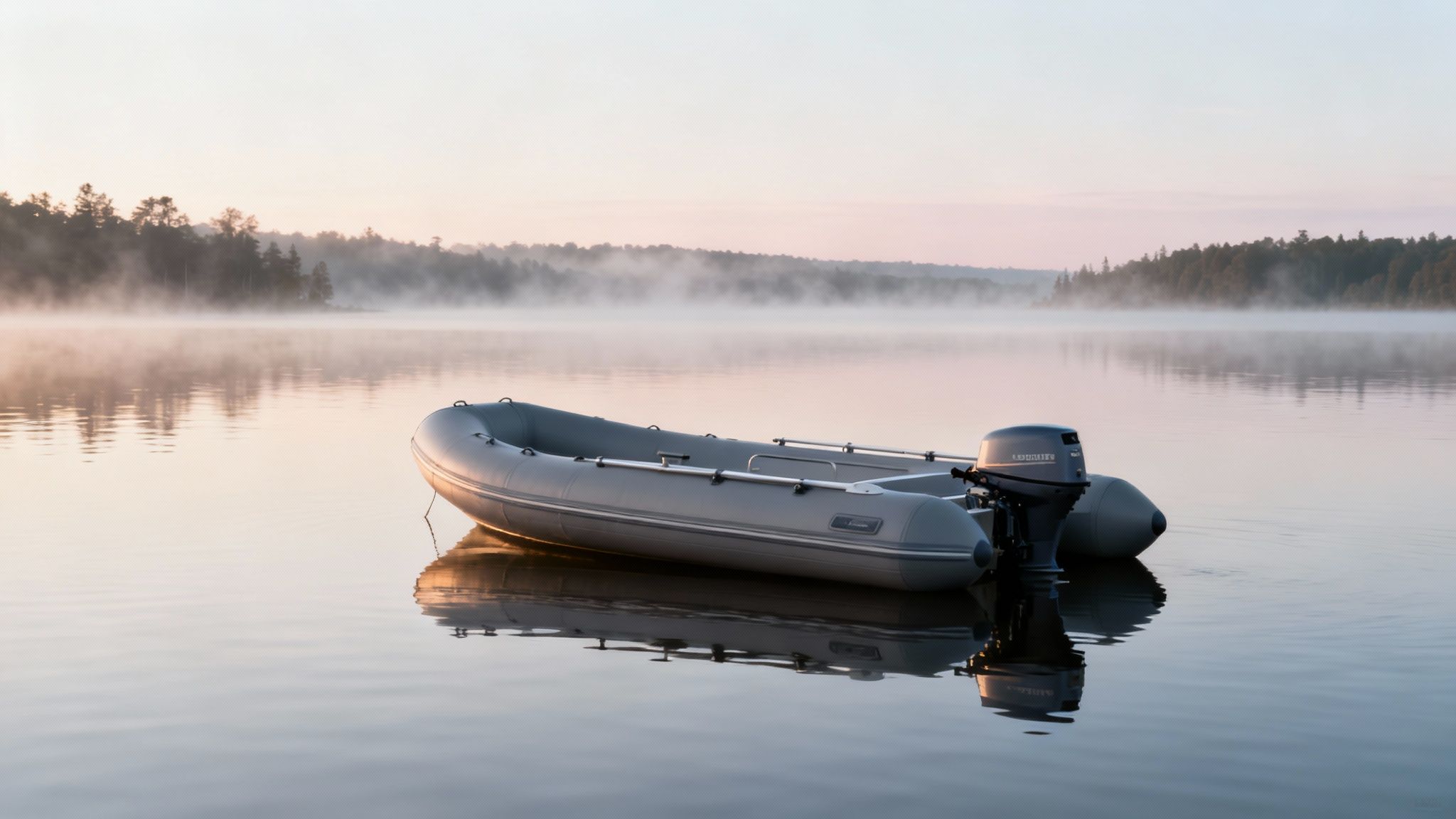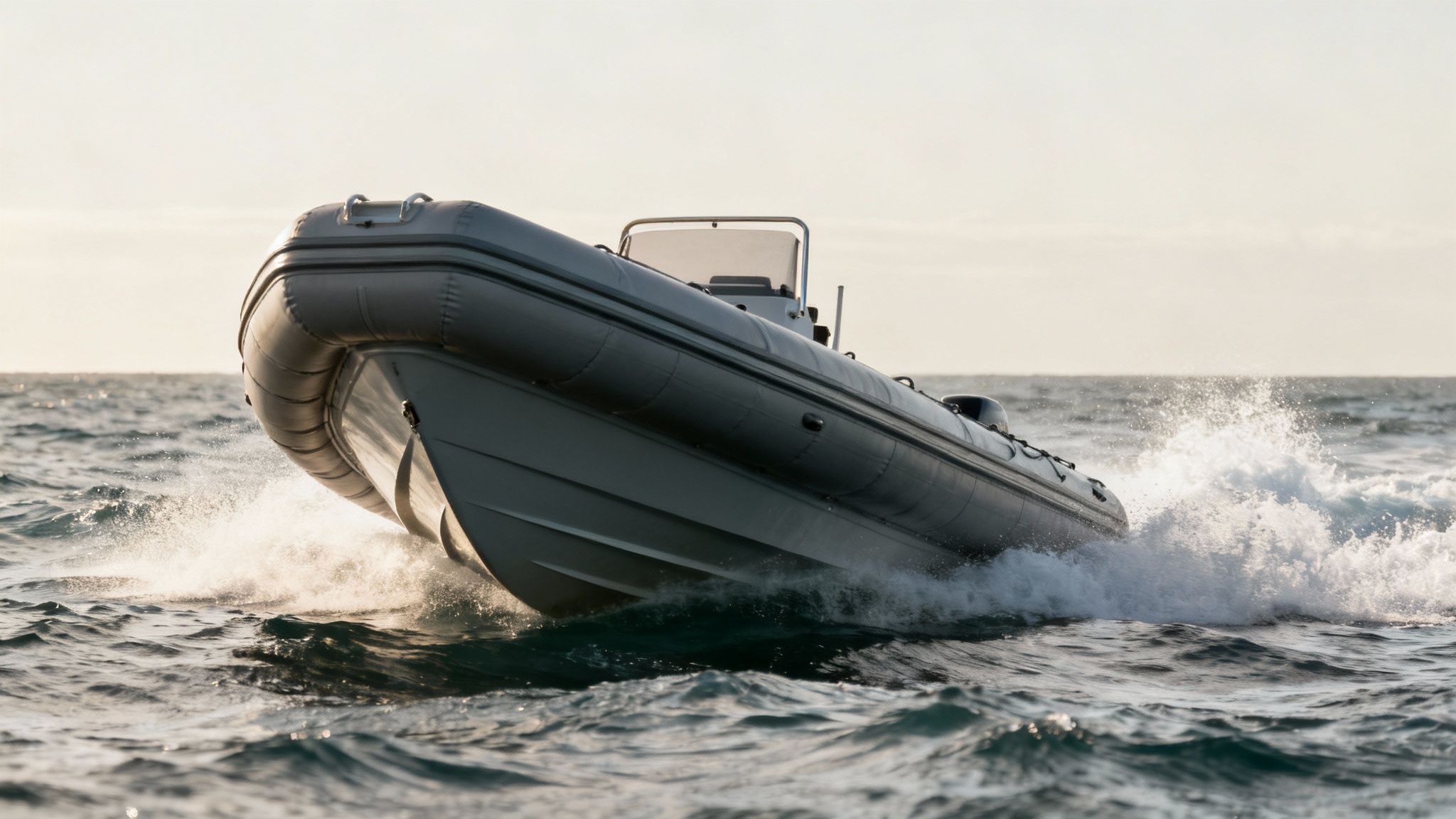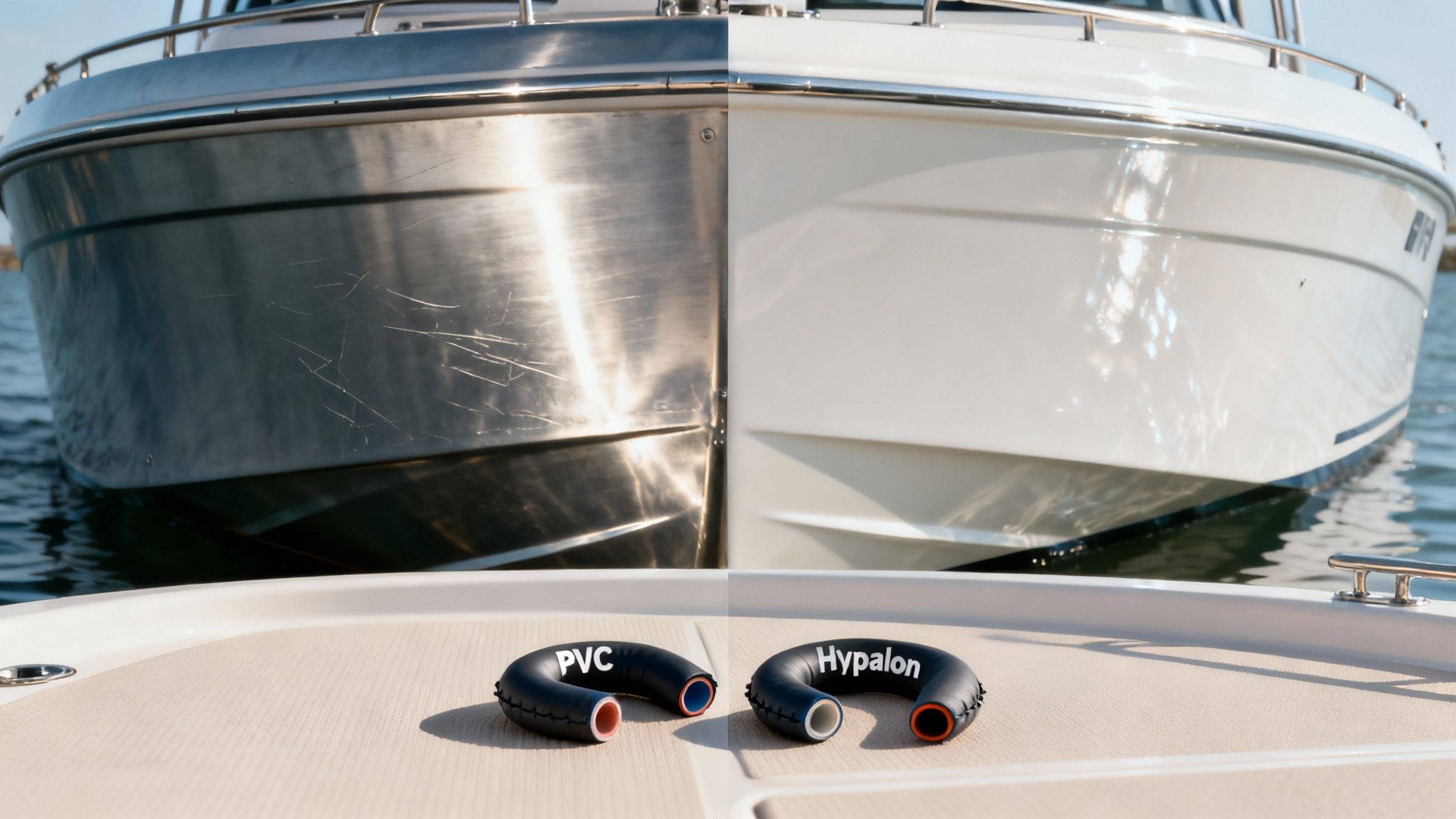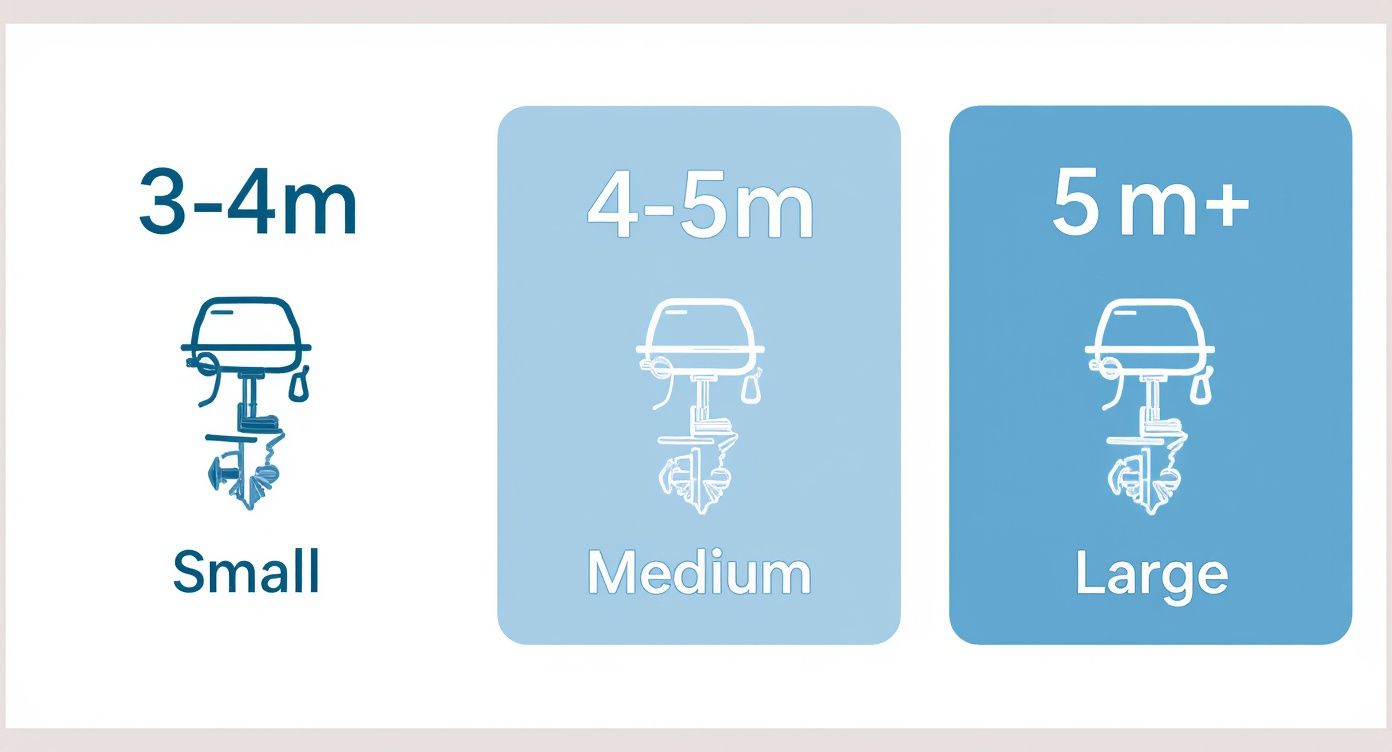
Diving into the world of Rigid Inflatable Boats (or RIBs) is an exciting move, but figuring out where to even start when you want to buy a RIB boat can feel a bit much. Think of this guide as your first mate, here to steer you through the essentials of picking a boat that's versatile, safe, and a perfect match for the Australian lifestyle.
We'll cover everything from what you'll be using it for and what the hull is made of, right through to engine choices, making sure you feel confident and clued-in on your final decision.
Setting out to buy a RIB opens up a world of new adventures, whether that's a quiet family day out on the bay or an adrenaline-pumping fishing trip offshore. The trick is to match the boat's features to what you actually need and to understand the unique demands of Australian waters. This isn't just about picking a model off a shelf; it's about finding a reliable partner for your water-based escapades.
And you're not alone—the popularity of these do-it-all boats is definitely on the rise. Australia's inflatable boat market has grown massively, which just shows how much we love getting out on the water. As of 2023, there were around 905,000 registered boats across the country, with over 15,000 new ones hitting the water in a single year. That's a lot of boaties.
This growth fuels a vibrant industry, from the big manufacturers right down to small, family-run businesses.
Before you even glance at a price tag or a features list, the first and most important step is to pin down exactly how you plan to use your RIB. Are you picturing:
Knowing what you’ll be doing most of the time will instantly narrow down your options. While RIBs are famous for being versatile, other boats are built for very specific jobs. To get the full picture, it’s worth exploring the different types of boats you can buy to be 100% sure a RIB is the right choice for you.
Getting this part clear from the start ensures you invest in a boat that will give you countless weekends of fun, not one that doesn't quite fit your vision.
So, what exactly is a Rigid Inflatable Boat, and why does it leave so many other boats in its wake? The real genius of a RIB is its hybrid design, bringing together the best of two very different worlds. It starts with a solid, high-performance hull and then adds large, inflatable tubes along the sides.

This simple combination is the secret sauce behind its incredible versatility and performance. It delivers benefits that neither a fully rigid boat nor a soft-bottom inflatable could ever hope to achieve on its own.
Think of a RIB as the ultimate 4×4 of the sea. The rigid hull is like a tough, powerful chassis, built to slice through choppy water with precision and strength. The inflatable tubes act like oversized, shock-absorbing tyres, giving you unmatched stability and safety, even when conditions turn rough.
This section will unpack the core benefits this design delivers, from being virtually unsinkable to offering a surprisingly soft and dry ride. It’s no wonder so many Aussies looking to buy a RIB boat are choosing this design for their adventures.
By far, the biggest advantage of a RIB is its incredible stability. The large inflatable tubes, often called sponsons, sit right on the water's surface, acting like outriggers on a canoe. This clever design lowers the boat's centre of gravity, making it exceptionally difficult to capsize.
This gives you huge confidence on the water, whether you're anchored with the family moving around the deck or navigating through a bit of swell. The tubes provide a level of buoyancy that makes the boat feel solid and totally secure underfoot.
A well-designed RIB is one of the safest forms of leisure boat on the market. The multiple air chambers in the inflatable tubes mean that even if one section is punctured, the boat will remain afloat and stable, allowing you to return to shore safely.
As a bonus, these tubes also act as a natural fender, protecting your hull from bumps and scrapes when docking or coming alongside other vessels.
A RIB’s solid hull, typically a deep-V design, is engineered to slice through waves rather than bounce over them like a cork. The result is a much smoother and drier ride compared to other boats of a similar size. The inflatable tubes also do a great job of deflecting spray away from the cockpit, keeping everyone on board comfortable.
This hull design also gives the RIB incredibly sharp, responsive handling. It can turn on a dime at speed with a sports-car-like feel, which makes it an absolute blast to drive. For anyone into watersports like wakeboarding or towing inflatables, this agility is a massive plus. The combination of a lightweight structure and a punchy outboard engine delivers exhilarating acceleration and surprisingly good fuel efficiency.
You can learn more about the specifics of a rigid hull inflatable design and its benefits in our detailed guide.
Seeing how these benefits play out in the real world is key. For those considering an entry-level purchase here in Australia, Aerowave offers some excellent options that really highlight the differences in design.
The Master series puts stability and utility first at a very accessible price point, while the Sprint leans into speed and agility. Both demonstrate the core strengths of the RIB concept, offering fantastic value for Aussie boaties.
The materials that make up your RIB are the very foundation of its performance, toughness, and how much you'll enjoy it over the long haul. When you set out to buy a RIB boat, getting your head around the difference between hull and tube options is one of the most important steps. This choice directly affects how the boat handles, how long it lasts, and the maintenance it will need, especially under the harsh Australian sun.

Let's break down the two most critical parts: the rigid hull and the inflatable tubes. Each comes with popular material choices, and they all have distinct pros and cons that suit different boating styles and budgets.
The rigid hull is what gives a RIB its wave-slicing performance and solid feel under your feet. The two main materials you'll find are fibreglass (also known as Glass Reinforced Plastic or GRP) and aluminium.
Fibreglass (GRP) Hulls
Fibreglass is the classic choice for a reason. Its biggest advantage is versatility—it can be moulded into complex, hydrodynamic shapes that deliver an incredibly smooth and quiet ride. These clever hull designs often give you superior handling, especially when the water gets choppy. On the downside, fibreglass is generally heavier than aluminium and can get chips or spider cracks if it takes a hard knock.
Aluminium Hulls
Aluminium is the rugged, lightweight champion of hull materials. It's incredibly tough and forgiving, making it the perfect choice for boaties who often pull up on sandy beaches or rocky shores. An aluminium hull can handle bumps and scrapes that would leave a fibreglass one needing repairs. It’s also lighter, which can mean better fuel efficiency and an easier time at the boat ramp.
It's this blend of durability and practicality that makes aluminium the exclusive choice for all Aerowave models, built for the varied conditions we see all across Australia.
The inflatable tubes are just as vital as the hull. They provide the boat's signature stability and buoyancy, essentially acting as a lifejacket for the entire vessel. The fabric they’re made from determines their resistance to UV damage, scrapes, and air loss. The main contenders here are PVC and Hypalon.
To help you visualise the trade-offs, here's a side-by-side look at the most common materials. This should make it easier to pinpoint what's right for your kind of boating.
| Material | Primary Advantage | Primary Disadvantage | Ideal For |
|---|---|---|---|
| Fibreglass | Smooth, quiet ride with superior hydrodynamic shapes | Heavier and can chip or crack on impact | Boaters who prioritise a comfortable ride in open water and handle their boat with care. |
| Aluminium | Extremely durable, lightweight, and impact-resistant | Can be noisier and rides rougher in some conditions | Adventurous boaters who beach their vessel, explore rugged areas, or want low maintenance. |
| PVC | Very affordable and durable with welded seam options | Lower resistance to long-term UV and chemical exposure | Recreational users, weekend boaters, and those looking for excellent value for money. |
| Hypalon | Exceptional UV, chemical, and abrasion resistance | Significantly more expensive than PVC | Commercial operators, serious boaters in high-sun climates, or for long-term investment. |
Ultimately, the best combination comes down to how and where you'll be using your RIB.
When you're ready to decide, think carefully about your specific needs. If you’re looking for a tough, affordable option for general fun on the water, a high-quality PVC like the German Mehler 1.2mm fabric found on the Aerowave Marine Master 300 or 360 is a fantastic and practical choice. For a deeper dive into the technical details, you can learn more about the benefits of Hypalon vs German Mehler PVC material in our detailed comparison.
However, if your boat will live in the sun or be used for demanding commercial work, investing in Hypalon—an option available on models like the Aerowave 330 and 350 Sprint RIBS—buys you serious peace of mind. That combination of a rugged aluminium hull with premium Hypalon tubes creates a RIB that is genuinely built to handle anything Australian waters can throw at it.
The engine is the heart of your RIB. It’s what turns a quiet float into a thrilling ride, so getting this choice right is a big part of the process when you decide to buy a RIB boat. The good news is, it's pretty straightforward. Almost all modern RIBs are paired with reliable and efficient outboard motors.
Your main decision will come down to two types of modern tech: direct-injection two-strokes and four-strokes. Forget everything you remember about old-school two-strokes being smoky and loud—those days are long gone. Today's direct-injection models are clean, quiet, and pack an incredible punch for their weight.
On the other hand, four-stroke engines run more like the engine in your car. They’re known for being exceptionally quiet at low speeds and delivering smooth, predictable power. It’s a bit of a trade-off between weight, cost, and fuel efficiency, but honestly, you can't go wrong with either. If you're curious about greener alternatives, our guide on electric outboard motors in Australia explores the future of boating power.
Even more important than the type of engine is matching its horsepower (HP) to your boat's size and how you plan to use it. This isn't just about performance; it's a critical safety issue.
Underpowering your RIB will leave it feeling sluggish. It’ll struggle to get on plane (that sweet spot where it glides on top of the water), especially when you’ve got friends and gear on board.
Overpowering a boat is just plain dangerous. It can make the vessel unstable, hard to control, and puts massive stress on the transom—the flat part at the back where the engine is mounted. Every single boat has a manufacturer-rated maximum horsepower, and you should never exceed it.
Finding that perfect balance means you’ll have all the power you need for a bit of fun without cutting corners on safety or efficiency.
To give you a starting point, here are some general rules of thumb for matching engine power to your boat’s length. Think of these as guidelines—always double-check the manufacturer’s specific recommendations for the model you’re looking at.
Remember, it's not just about top speed. Having the right amount of power means the engine isn't constantly straining to hold a comfortable cruising speed. This often leads to better fuel economy and a longer life for your motor, making it a smarter investment in the long run.
Theory is great, but seeing how it all comes together in the real world is what really helps. Now that we’ve covered the nuts and bolts of hulls, tubes, and engines, let’s look at some popular, real-world examples. For anyone looking to buy a RIB boat in Australia, digging into a local brand like Aerowave Marine is a fantastic place to start.
We’ll put two of their main series under the microscope: the rugged Marine Master and the agile Sprint. This comparison will break down the key differences in their design, materials, performance, and price tag, helping you match the right model to your boating lifestyle.
Think of the Aerowave Marine Master 300 and 360 models as the dependable utes of the water—tough, practical, and ready for pretty much anything you can throw at them. They’re built with durability and stability front and centre.
Both models feature a robust aluminium hull and are kitted out with heavy-duty German Mehler 1.2mm PVC tubes. This combination delivers fantastic durability at a price point that makes getting into RIB ownership genuinely accessible.
While the Master series is all about utility, the Aerowave Sprint 330 and 350 are engineered for a bit more thrill. These models feature a lighter build and a more performance-focused hull design, making them quicker off the mark, more nimble in the turns, and an absolute blast to drive.
The Sprint series is aimed squarely at boaties who want to feel the wind in their hair, whether that’s for watersports, zipping between islands, or just enjoying a fast, responsive ride.
Choosing between a utility boat and a performance one comes down to being honest about what you’ll actually do. If 90% of your time will be spent fishing at low speeds, a stable workhorse is your best bet. If you dream of carving across the bay, a lighter, performance-oriented model will bring you a lot more joy.
Both the Sprint 330 and 350 come with the option to upgrade from the standard high-quality PVC to premium Hypalon tubes. This is a brilliant long-term investment, especially if your boat will be living under the harsh Australian sun. You can learn more about the specific Aerowave inflatable boats available in Australia and see what customisation options they offer.
This infographic gives you a general idea of how to match engine power to your RIB’s size—a key decision for both the Master and Sprint series.

As you can see, smaller boats get up and go with less horsepower, while the bigger vessels need more grunt to handle the extra size and weight.
To make the choice even clearer, here’s a side-by-side look at the key specs and features of the Aerowave Marine Master and Sprint models. This table breaks down everything from hull material to target use, helping you pinpoint the perfect boat for your needs.
| Model | Length (m) | Hull Material | Max HP | Key Feature | Target Use | Affordability |
|---|---|---|---|---|---|---|
| Marine Master 300 | 3.0 | Aluminium | 15 | Robust build, exceptional stability | Tender, solo fishing, calm water exploring | Most affordable |
| Marine Master 360 | 3.6 | Aluminium | 30 | Increased space and passenger capacity | Family outings, fishing with a mate | Very affordable |
| Sprint 330 | 3.3 | Aluminium | 25 | Lightweight and agile, performance hull | Watersports, fast cruising, exploring | Mid-range |
| Sprint 350 | 3.5 | Aluminium | 30 | Top-end speed with Hypalon upgrade option | Thrill-seeking, island hopping, long-term use | Higher-end |
Ultimately, the Marine Master series offers unmatched value and toughness for everyday use, while the Sprint series provides that extra dose of excitement and performance for those who want to push the limits.
When you’re ready to buy a RIB boat, the price is always a huge part of the conversation. The Aerowave models are positioned to offer excellent value, but there are clear differences between the two series.
The Aerowave Marine Master series is the most affordable option of the two. Its straightforward design, tough aluminium hull, and durable German Mehler PVC tubes keep the cost down without sacrificing the core strengths you expect from a great RIB. It’s the perfect entry point for budget-conscious buyers who need a reliable boat that can take a few knocks.
The Aerowave Sprint series sits at a slightly higher price point. This reflects its lighter construction, performance-first design, and the valuable option for a premium Hypalon tube upgrade. While still very affordable compared to many other brands, it’s an investment in higher performance and longevity—a choice that aligns with Australia’s thriving boating culture.
You’ve done the research, you've narrowed down the field, and now it’s time to make the final call. This is where the tyre meets the road—or in this case, the hull meets the water. Think of this checklist as your last line of defence, a practical guide to ensure you’re making a smart buy and not just an emotional one.
First things first, you need to decide: new or used? A shiny new boat brings that factory-fresh feeling, a full manufacturer's warranty, and all the latest bells and whistles. It's peace of mind in a box. On the flip side, a pre-loved boat can be a fantastic way to get more bang for your buck, letting you step up in size or features without blowing the budget.
The great news is that the small boat market, where RIBs are a huge player, is booming. Forecasts show the sector is expected to grow from an estimated $271.7 million in 2024 to a whopping $780 million by 2035, thanks to a surge in recreational boating. This means there's a healthy supply of both new and used boats, giving you plenty of options to find the perfect fit. You can read more about these exciting market trends for small boats in Australia and the Pacific.
Whether you go new or used, a hands-on inspection is absolutely non-negotiable. Don’t just stand back and admire it—get up close and personal.
The most important step before you buy any boat is the sea trial. This is your only chance to feel how the boat handles on the water. Pay attention to how it gets on plane, how it turns at speed, and how it handles chop. Never buy a boat you haven’t personally tested on the water.
Okay, so the boat looks solid. Now it’s time for the final bits of admin that will keep you safe and legal on the water here in Australia.
Essential Final Checks:
Working your way through this checklist isn't just about ticking boxes. It’s about making a confident, informed decision that will lead to years of fun out on the water.
Getting to the final stages of buying a RIB boat can bring up a few last-minute questions. It’s a big decision, so getting clear, honest answers is the best way to feel confident before you commit. Here are some of the most common queries we get from buyers all over Australia.
You’ll find RIB hire companies dotted around most major coastal hubs and waterways. Think places like Sydney Harbour, the Gold Coast, the Whitsundays, and Perth’s Swan River. Your best bet is to start by checking in with local marinas and watersports businesses.
A quick search online for "RIB boat hire" followed by your location will bring up a heap of options. When you book, just make sure the hire includes a full safety briefing and all the legally required gear. It’s a small step that gives you huge peace of mind.
Honestly, the "best" boat is always the one that fits what you want to do and what you want to spend. For general family fun and weekend cruising, brands like Zodiac, Highfield, and BRIG are all fantastic, popular choices here in Australia.
The Aerowave models we've covered in this guide, like the Marine Master and Sprint series, are also brilliant options known for being tough and great value. Nothing beats seeing them in person, though. Try to visit a local marine dealer or a boat show to get a real feel for their size, layout, and features.
A great place to start is by visiting the Australian websites of the major brands. This will give you a solid baseline understanding of their different models and what comes standard.
To get a bird's-eye view of the market, jump on online marketplaces like boatsales.com.au. These sites let you compare new and used listings from dealers and private sellers, helping you get a feel for current market prices and what’s available in your area.
But for the most accurate pricing on the specific boat, motor, and trailer package you’ve got your eye on, nothing beats talking to a local dealer. They can draw up a detailed, itemised quote that covers everything you need to get on the water.
Ready to find the perfect RIB for your next adventure? At Easy Inflatables, we specialise in high-quality, affordable Aerowave RIBs designed for Australian conditions. Explore our range and build your ideal boat package today.
Browse Our Full Range of RIBs and Inflatables at Easy Inflatables
Experience the ultimate freedom on the water with our top-quality inflatable boats and accessories. Easy Inflatables is your trusted partner, providing everything you need for a safe and unforgettable adventure.
At Easy Inflatables, we believe in empowering adventurers with high-quality inflatable solutions. Our commitment to durability and performance ensures that every product enhances your outdoor experiences.